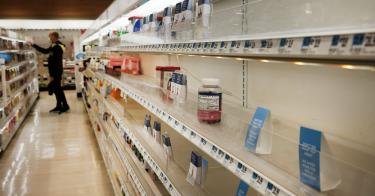Pictures of container ships anchored near the government-owned ports of Los Angeles and Long Beach are all over the news and social media. Together, these ports process about 40% of all containers of goods entering the U.S. More than 70 ships are waiting at anchor off the coast of L.A.
Thousands of containers are onboard, full of everything from car parts to baby diapers. New ships arriving at the ports are facing up to three-week delays in unloading and processing. To say the system is in crisis mode would be an understatement.
Meanwhile, Americans nationwide are facing shortages. In Iowa, schools are having a hard time sourcing the quantity of food needed for their breakfast and lunch programs. Food producers are missing inputs like resin for packaging, while small businesses across the country are facing shortages of bulk items like utensils, cups and to-go boxes.
>>> Blame Government, Not COVID-19, for Supply Chain Collapse
A food truck owner in Maryland told ABC News, “It would be one thing if I couldn't find french fries. We can change that, but when we got nothing to put it in, it's heartbreaking and stressful.”
The Biden administration attributes these delays and shortages to worldwide factory disruptions during the pandemic and increased consumer demand. While these certainly play a role, the administration is not telling the whole story.
What led to this crisis is a system of government-imposed regulations that seemed innocuous when the economy was healthy. However, the pandemic drew the immense burden of this red tape out of the shadows. A series of barriers in California, and at the federal level, prevented the market from responding efficiently to the demand for processing at the L.A. ports.
First and foremost, union hour rules for longshoremen and truckers have resulted in port operations not matching the influx of ships. The Port of L.A. has been operating at only 60% to 70% of capacity, closed evenings and Sundays.
President Joe Biden announced on Oct. 13 that the port would switch to 24/7 operations. But the neighboring Port of Long Beach promised this months ago, yet it’s still only running four days per week.
At the same time, California’s AB 5 law is restricting independent contractors, which includes many truckers, from stepping in. And the state’s new emissions mandates limit the number of trucks able to even operate there. Amid such rules, California now has half the trucker density as states such as Texas, Pennsylvania and Ohio.
Finally, a century-old trade law called the Jones Act makes it cheaper for companies to ship goods from Asia than between U.S. states. This increases rail and truck traffic between states when transporting goods by ship (for example, between Washington State and California) could be cheaper and more efficient.
To add insult to injury, the L.A. ports just announced a new fine system for containers that remain at the ports too long, even though there aren’t enough trucks on the road to transport the containers. Additionally, Biden’s impending vaccine mandate would worsen the nation’s labor shortage.
So how do we fix this crisis?
>>> More Bad Policies and Government Spending Will Worsen Labor Shortage
The first step is to recognize that the government is causing much of the problem--and new government restrictions won’t fix it. Without those regulations, the market would have been able to respond more quickly to the rising number of ships, additional workers and shifts could have been implemented, and 24/7 would mean what it says. With fewer restrictions, available trucks would be able to come from neighboring states to get containers and goods out of the overloaded ports—and into the hands of frustrated Americans.
The California ports should start running 24/7 today. The federal government and California should remove labor and environmental regulations that disincentivize work and make it more difficult for goods to get from the ships to our shelves. And they certainly should refrain from imposing new ones that make it worse.
This crisis is proof that government bureaucrats and government-controlled unions cannot, and often will not, change course when the market demands it. It is time to remove the red tape for the long term to both solve the current crisis and prevent future ones.
This piece originally appeared in The Sacramento Bee



